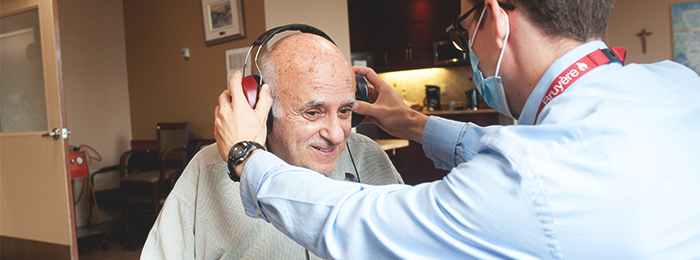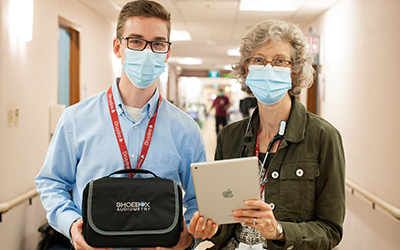
The sound of innovative care – piloting new auditory screening tools at Bruyère
Whether listening to the birds singing on a morning walk or enjoying a heartfelt conversation with a friend, the ability to hear can have a profound impact on our quality of life – yet many people are unaware that they are experiencing hearing loss. In fact, more than half of Canadians aged 40 to 79 have measurable hearing loss, and a staggering 93% of Canadians aged 70 to 79 have hearing.1
In order to bring better and faster auditory screening to our patients, Bruyère has launched a pilot program with industry partner, SHOEBOX Ltd. Due to the slowly progressing nature of hearing loss, the majority of patients weren’t even aware that they had a reduced auditory experience.
This pilot was made possible by a research partnership with the CAN Health Network. This Network supports health care organizations to collaborate with Canadian health technology companies by bridging the research-innovation-implementation cycle.
In this case, by researching and studying the feasibility of the SHOEBOX Quicktest in our Bruyère Memory Program, we were able to then scale the product into our Geriatric Rehabilitation Program using funds supported by the Network.
The SHOEBOX QuickTest, a first of its kind evidence-based iPad auditory screening tool, provides patients with an accurate hearing score in under two minutes. Screening results are shared with the patient and their care team within days of admission, equipping patients to take the next steps in their auditory care and informing Bruyère on how to optimize communication with the patient.
 Dr. Anne Harley who works at the Geriatric Rehabilitation Program at Bruyère immediately saw the role SHOEBOX QuickTest could play in improving patient care and is excited about Bruyère’s early adoption of the tool.
Dr. Anne Harley who works at the Geriatric Rehabilitation Program at Bruyère immediately saw the role SHOEBOX QuickTest could play in improving patient care and is excited about Bruyère’s early adoption of the tool.
“A patient’s ability to hear and understand the care team is a crucial part of implementing our care plans,” Harley explained. “I’m pleased to be a part of a team at Bruyère that is piloting innovative tools that can have a positive impact on the health care system as a whole.”
An early recipient of the SHOEBOX QuickTest shared, "I really like this test." After going 25 years without an assessment, and despite being used to traditional audiologist assessments from his days as an airplane technician with the Canadian Air Force, he said, “It was easy to use; I didn’t have to wait long and my hearing results were right there.”
The impact goes beyond the individual, there are system-wide costs for every patient that goes with untreated hearing loss. In an American study, compared to individuals without hearing loss, those with untreated hearing loss were associated with a 46% increase in additional health care costs to the system over a ten-year period. They also experienced, on average, 1.47 more inpatient stays, were at greater risk for 30-day hospital readmission, and had 52.2 more outpatient visit days, taxing patients as well as the health care systems that support them.2
Early data already suggests that Bruyère’s adoption of SHOEBOX QuickTest is successful at identifying undiagnosed hearing loss in patients. It is providing physicians with an objective auditory screening tool that is impacting patient care, showing promise in helping the overall health care system, and, most importantly, helping patients return home with the highest quality of life possible.
1. Statistics Canada. Hearing loss of Canadians, 2012-2015. Health Fact Sheets (2016).
2. Reed, N. S., Altan, A., Deal, J. A., Yeh, C., Kravetz, A. D., Wallhagen, M., & Lin, F. R. (2019). Trends in Health Care Costs and Utilization Associated With Untreated Hearing Loss Over 10 Years. JAMA otolaryngology—head & neck surgery, 145(1), 27–34.